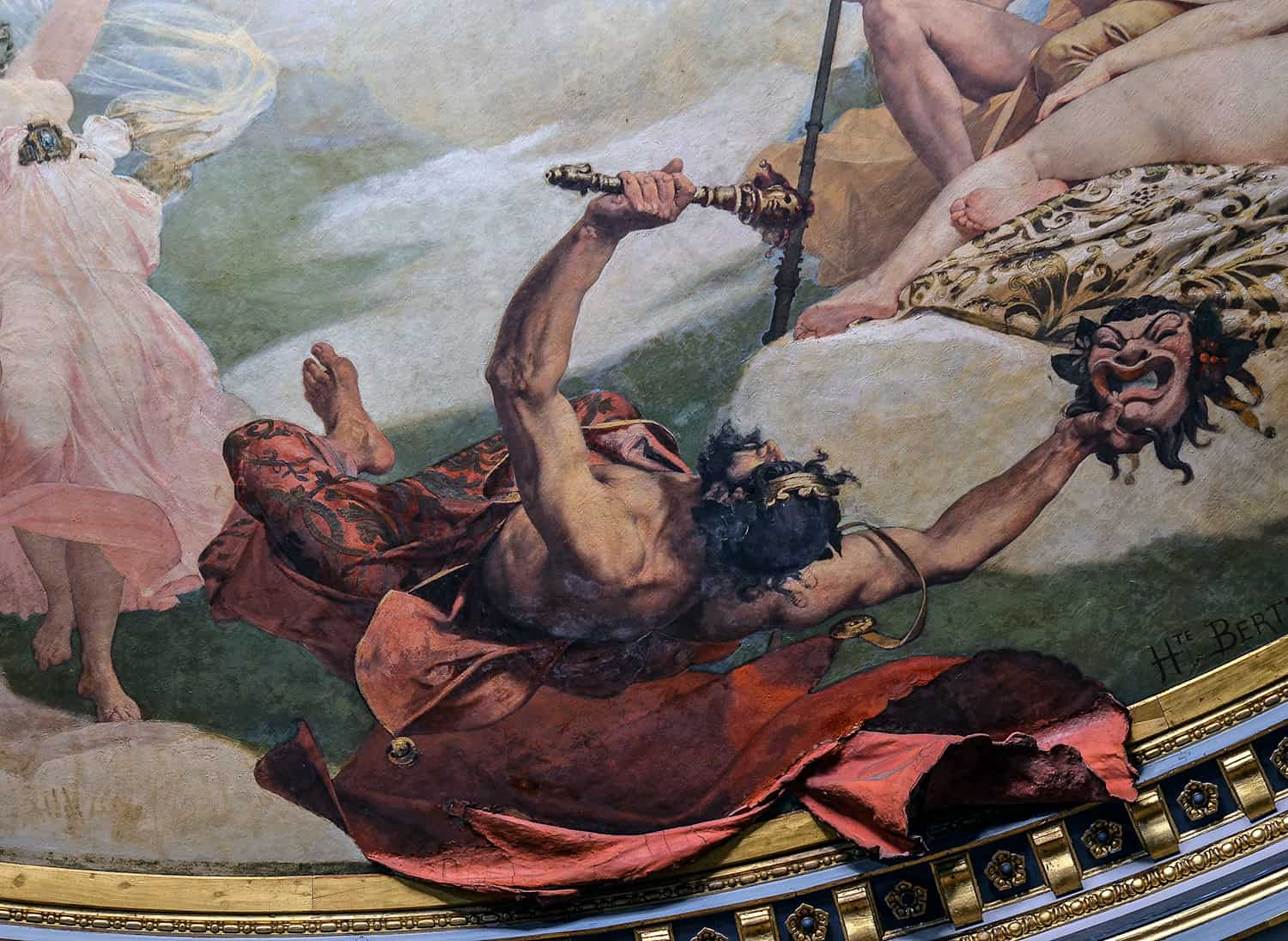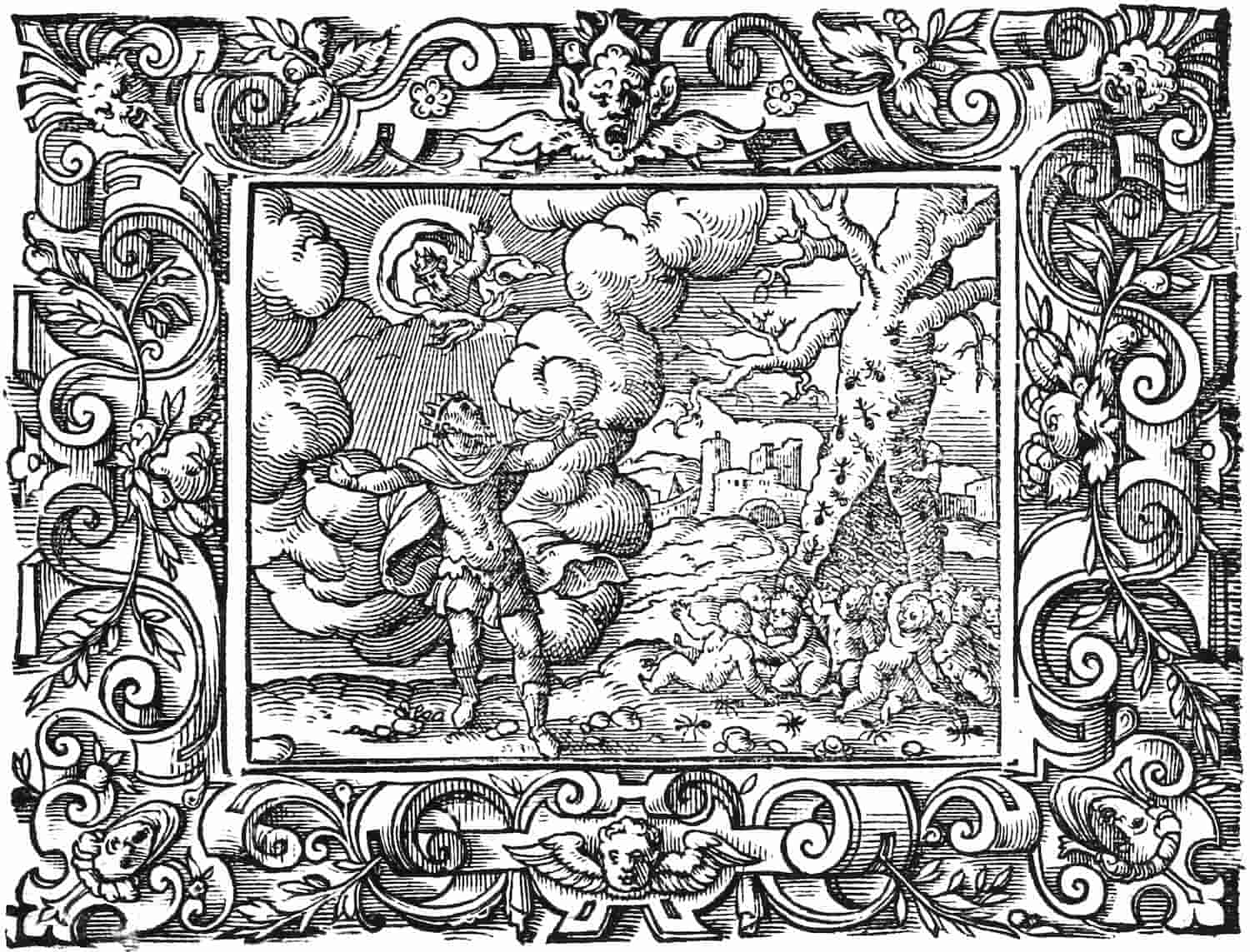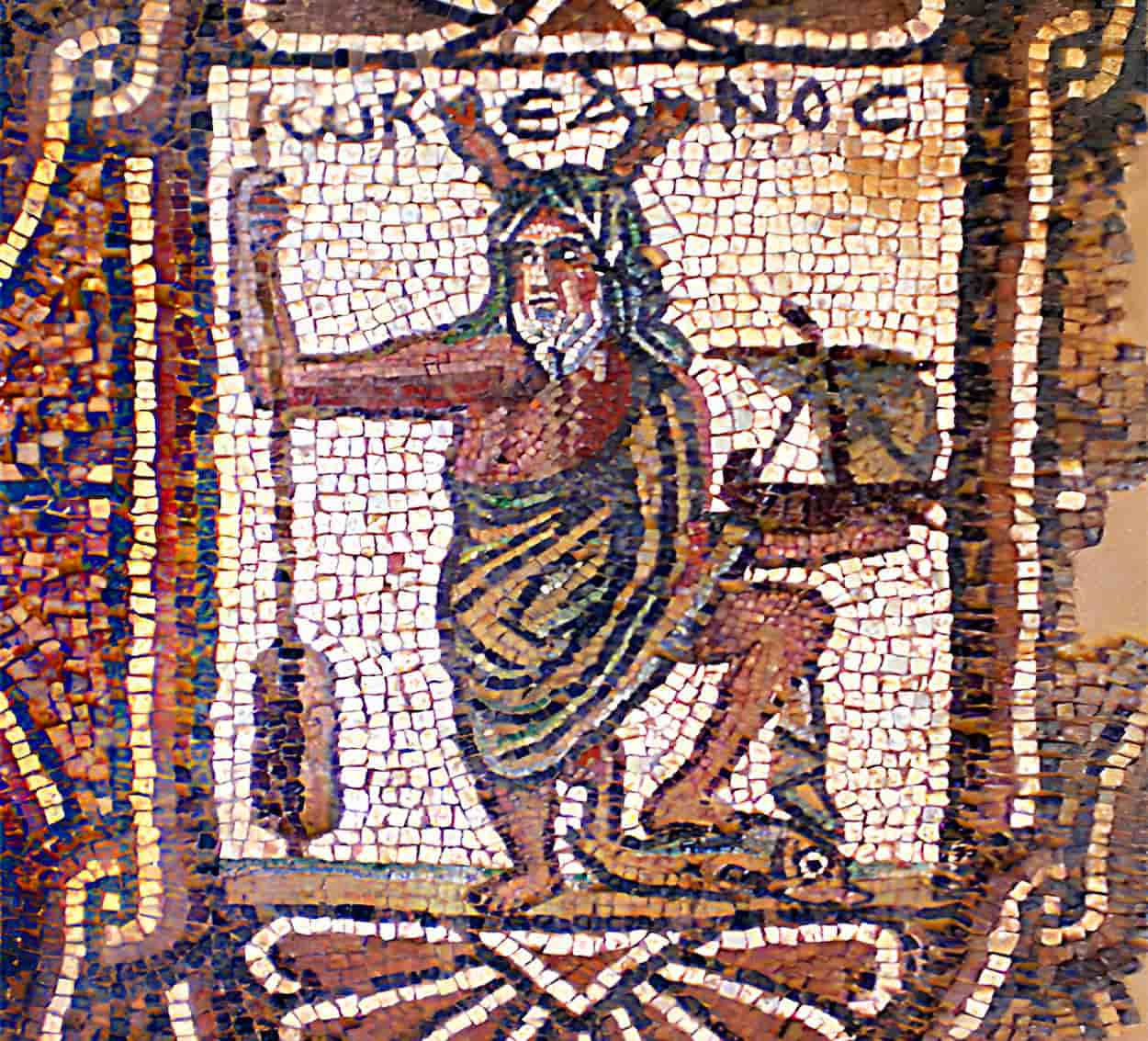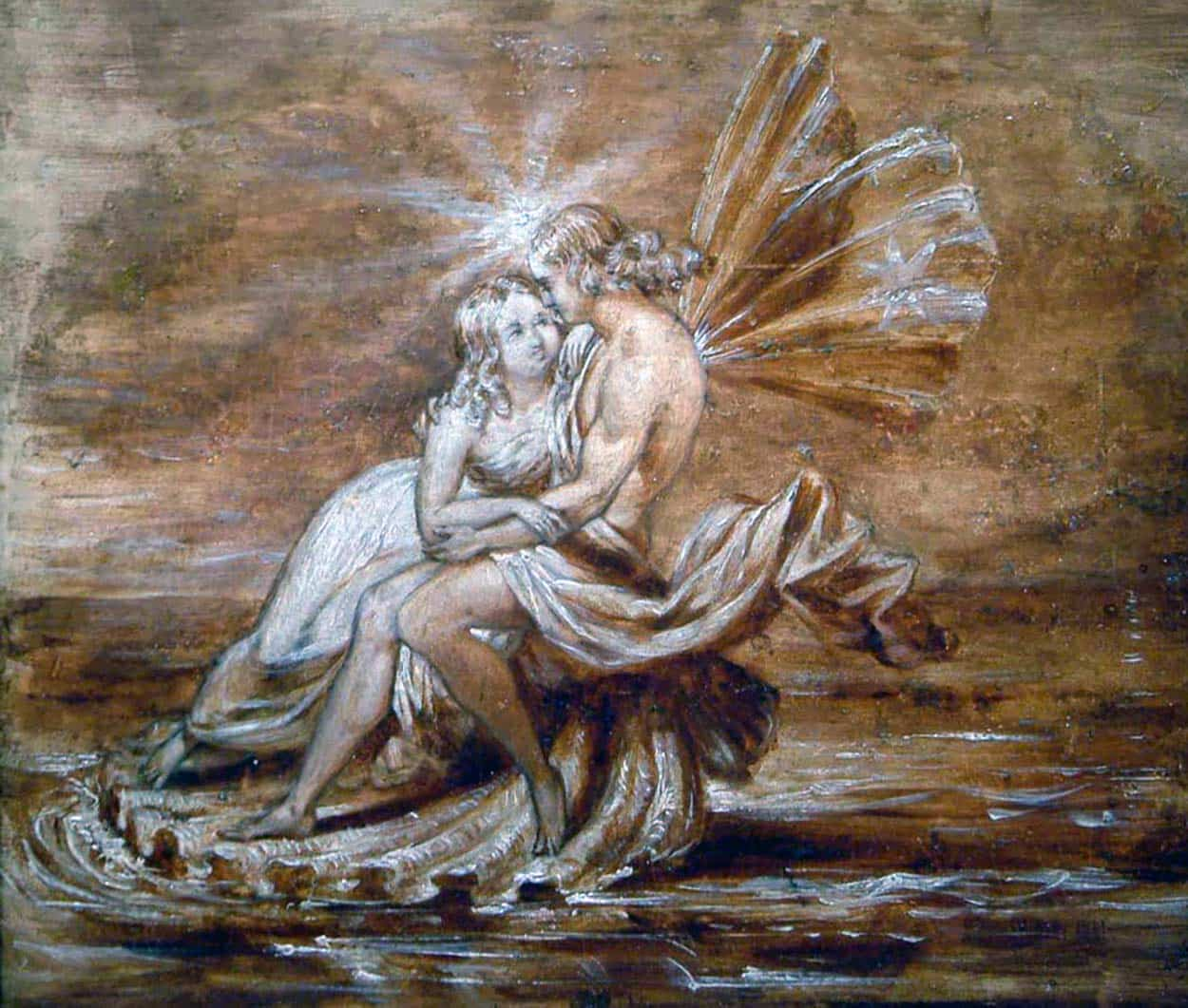Momus (Ancient Greek Μῶμος Mṓmos) is, according to Hesiod’s Theogony, one of the numerous sons of Nyx and the personification of criticism and fault-finding. In Roman mythology, his counterpart is Querella. Momus is a minor Greek deity, representing mockery, wordplay, and mocking criticism. He is the son of Nyx, either conceived by her alone or with Erebus, the Darkness, depending on the version. Momus is the brother of Moros, the Keres, and Thanatos—three personifications of Death—as well as Hypnos, the twin brother of Thanatos. His counterpart is Eupheme, the goddess of praise.
Ancient Myth
As the personification of Sarcasm and Mockery, Momus is the god of ridicule and mischievous critiques. He serves as the jester among the Olympian deities. It was Momus who suggested to Zeus, in order to curb the increasing population of humans that began to worry him, to marry Thetis to a mortal and father the beautiful Helen, the seductive cause of the Trojan War. However, after mocking all the gods, he was expelled and took refuge with the only god capable of tolerating him: Dionysus. He is equated with the Latin Momus.
Regarded as a master of sharp criticism, Momus did not spare even the gods. In Aesop’s fables, there is a key scene: “Zeus had created the bull, Prometheus the human, and Athena the house, and now they demanded Momus’s judgment. However, he envied the creative power of others and said, ‘You all made mistakes. Zeus should have placed eyes on the horns of the bull, so it could see where it was striking. Prometheus should have turned the inside of humans outward, so villains couldn’t deceive others. Finally, Athena should have put the house on wheels, so one could quickly move on if they had a bad neighbor.'”
Significance in Mythology

Momus was expelled from Olympus because he questioned the god Zeus. He was often depicted holding a staff with the upper end shaped like a woman’s head.
According to Greek mythology, as humans multiplied and burdened Gaia, she complained to Zeus to lighten her load. Zeus instigated a war, the Theban War, in which many people were killed, and thus Gaia was relieved. However, the problem reappeared later, and Zeus sought the assistance of other gods. At that time, Momus, the son of Nyx—according to some, of Themis and Hypnos, and according to others, of an unknown father—advised Zeus to give birth to a beautiful daughter and marry the Nereid Thetis to a mortal. Zeus followed the advice, giving birth to Helen from Leda and marrying Thetis to Peleus. These two events led to a major war more deadly than the previous one, known as the Trojan War.
Momus is mentioned by Lucian in his work “Assembly of the Gods,” criticizing Zeus for his transgressions, resulting in the manipulation of the divine council by joining mortal women. This deity also condemned the god Hephaestus because, when creating humans, he did not include windows in their chests so that the world could see their thoughts and determine if they spoke truth or lies. It is said that Momus died of grief because he couldn’t find any flaw in the goddess Aphrodite.
In human imagination, Momus abruptly turns their fortunes upside down. He plunges them from happiness into misery, transforms their successes into failures, and turns their “triumphs” into despair.
Interpretations
His fault-finding was so excessive that it spared not even those presumed flawless.
“No, Venus might as well remain naked / Since Momus long ago could find nothing to criticize about her / Except the horned shoes.”
Due to his penchant for criticism, he was eventually expelled from Olympus by Zeus. This action was criticized as a mistake by the Enlightenment publicist Gottlieb Wilhelm Rabener: “The gods would have had a very imperfect heaven without Momus. Someone among them was necessary, whose desire to speak ill they had to fear. Their company would have become too sleepy; they would have paid too little attention to themselves.”
His traditional profile, therefore, reads: “Among the great multitude of gods, invented by the heathens themselves, there is also one named Momus, about whom poets fable that he is such a god, begotten by Sleep as the father, and born by Night as the mother. He never dared to do anything himself, to undertake or accomplish anything. Instead, he keenly observed, mocked, criticized, and scornfully dragged through the mud the work, labor, and business of all other gods. And where he thought something had been forgotten or poorly done, he freely and without hesitation judged, censured, and punished it.”
The cause of his mockery, according to Aloys Blumauer, is the following event:
“The old Momus, who until now / At the court of Father Jupiter / Played the jester, / When he once bumped into Juno’s little pug, / Received such a bite from him, / That he howled in pain. / And because the little dog was furious, / The poor fool became so too, / His mouth and throat swelled; / And every little word he spoke, / Turned into poison on his tongue, and stabbed / The gods in the soul.”
His criticism became a proverbial standard since the Baroque era, as seen in Johann Hermann Benner’s statement: “His arrangements are so regular and innocent that even Momus cannot criticize them.” The Enlightenment thinker Barthold Heinrich Brockes also refers to him in his Moral Poems (1736): “With your objection, you come to me, beloved friend, like Momus, who, before he should consider us perfect, wanted to be at the window of humanity.”
Modern Legacy of Momus
This deity is depicted lifting his mask and holding a marotte, a symbol of madness. He often accompanies Comus, the god of feasting and libertinage.
Momus in Opera
Momus appears in the “ballet bouffon” by Jean-Philippe Rameau, Platée, with a libretto by Adrien-Joseph le Valois d’Orville, adapted from Platée or Juno Jealous, a play by Jacques Autreau, itself inspired by the Béotiques, Book IX, Chapter III, of the Description of Greece by the Greek geographer-historian Pausanias. Momus also appears in Les Fêtes d’Hébé (1739), also by Rameau (libretto by Gauthier de Montdorge, Abbé Pellegrin, and Le Riche de La Pouplinière), where, in the prologue, Momus is the confidant of Hébé, and the Graces present them with the attributes of Love.
In this opera-ballet (Platée), Momus, in the prologue, encourages Thespis, the mythical inventor of comedy, not to spare the immortals in his mockery. In the second act, he organizes, at Jupiter’s command, a celebration in honor of the water nymph, an unfortunate victim of the deception of the most powerful of gods.
Jean-Sébastien Bach composed a secular cantata Geschwinde, ihr wirbelnden Winde (BWV 201) in Leipzig in 1729 as Drama per musica. The theme revolves around the struggle between Phoebus and Pan in Greek mythology, with Momus serving as the arbiter.
The piece was performed again in 1735-1740 and in 1749 in Leipzig.
Act II of Giacomo Puccini’s La Bohème is set in Café Momus in Paris, a place that actually existed.
Momus and the Goguettes
Dedicated to joy, at least fifteen festive and singing societies in 19th-century France adopted names referring to Momus. In Dunkirk, there was the Literary Society of Petit Couvert de Momus. In Lille, the Society of Momus. In Paris and its surroundings, there were the Suppers of Momus, the Evenings of Momus, the Children of Momus, the Children of Momus at the Moulin d’Amour, the Children of Momus at the Barrier of the Three Crowns, the Supporters of Momus at the Courtille, the Momusians, the Banquet of Momus. Marc-Antoine-Madeleine Désaugiers was invited to the latter society on a specific occasion and wrote a song for it: the Little Momus, the Merry Momusians, the Society of the Children of Momus in Meudon, the Society of the Children of Momus in Saint-Germain-en-Laye, and the Society of the Children of Momus in Versailles.
Momus at the Galveston Carnival (Texas)
A Carnival fraternity, the Knights of Momus, was founded in 1871 in Galveston, Texas. This fraternity disappeared during World War II, and a new group was founded in the mid-1980s. Seeking to revive the spirit of the original group, it adopted the name Momus.
Momus at the New Orleans Carnival
Founded in 1872, one of the three oldest societies of the New Orleans Carnival is called, like the one in Galveston, Texas, the Knights of Momus.
Iconography
Joachim von Sandrart summarizes the ancient description in a copperplate engraving:
“Momus is a god of reproach and slanderous speeches / a son of Dream and Night / of deformed and hideous form / offensive to himself and everyone / scorns all art and good laws / mocks them / strikes them / and barks at everyone / like an evil dog.”
In Leonard Defraine’s La Mythologie en Estampes, the various depictions of Momus merge into a generalized depiction of the fool. The mask in front of the face is increasingly omitted and replaced by the jester’s cap.
The symbol of his folly that remains is the marotte in his hand. The “fool’s scepter,” also called “fool’s club,” is said to represent the ugly Momus on the grotesque face. In the German Proverbs Lexicon, it is stated: “Fool’s club (…) a short stick with a cut-out grotesque face and a jester’s cap… with which folly and the god of criticism and mockery (Momus) are depicted…”
Reception
Already in the Early Renaissance, Momus served as a model for candid criticism, as seen in 1440 by the Genoese architectural critic Leon Battista Alberti. In his political fable “Momus o del principe,” Alberti processes his experiences as an associate of Pope Eugene IV and as the architect for princes, addressing their arrogance through dialogues that, upon reading, leave laughter stuck in one’s throat.
For the Italian philosopher Giordano Bruno, who met his end as a heretic on the pyre, Momus was the archetype for criticizing the powerful. In “Spaccio de la bestia trionfante” (1584), Bruno urges that, instead of the pleasures of the gods, there should be the “proclamation of truth, tyrannicide, zeal for the fatherland and personal affairs, tireless vigilance, and concern for the state” (Third Dialogue). The court jester of the godly realm becomes a quasi-atheistic, certainly malicious cynic.
The encryption of criticism towards the nobility and courtly establishment onto the rulers of the divine realm, with Momus as an advocate for the oppressed, is also found in the works of the English playwright John Dryden. In “The Secular Masque” (1700), the gods must face the critique of their arrogance and the futility of their pastimes. From the mocker’s perspective, neither hunting (Diana), nor war (Mars), but especially love (Venus) have a claim to lasting appreciation.
For Johann Georg Jacobi, the ‘Professor of Fine Arts’ in Freiburg, Momus is also a keen observer of the culture of cosmopolitan citizens. When showing his ‘boss’ Jupiter what “his little earthly people were up to,” Momus pulls various contemporaneous absurdities from his collection:
“Doctor Faust with his devils, / And Robinson on his journey; / On the shadowy grape-hill, / Anacreon’s anointed beard: / Candide, Solon, Eulenspiegel, / Confucius and Aretin, / And Swedenborg and Harlequin / Crawled out of a single egg; / The hermit by the bones of the dead; / Armida by Rinaldo’s kiss; / And finally concluded the assembly / Alchemists, critics, prophets, / Druids, sorcerers, poets.”
Later References
The Leipzig Court Councillor and scholar Johann Burckhardt Mencke saw himself as a ‘Reasonable Momus’ and used Momus’s (supposedly only) satirical gaze and the vices he criticized, such as extravagance, vanity, and deceit, to expose the typical ‘Cavaliers and Ladies.’
The name ‘Momus’ is considered a synonym for any form of satire, as seen in 1693 in the Early Enlightenment writing “Der unsinnige Momus.” Anonymously published in 1762, “Momus, Neuer und lustiger Mischmasch” contained amusing, occasionally disparaging miniatures and notes, leading to its inclusion on the list of banned writings in 1816. Regular publications like “Momus ridens, or comical remarks on the publick reports,” one of the first weekly ‘satire magazines’ in London from 1790 to 1791, or “Momus. Taschenbuch für Freunde des Scherzes und der Satyre” also existed.
In the libretto “Des Amours De Momus,” Joseph-François Duché de Vancy portrayed the God of Mockery in a more amiable light, as he competes with the handsome water god Palemon for the favor of the nymph Melitte. Fortunately, the servant of the goddess of youth, Hébé, also values inner qualities.
In the artist novel “Scènes de la vie de bohème” (1849) by Henri Murger, the meeting place for quarrelsome artists in the Latin Quarter is Café Momus. Giacomo Puccini’s opera “La Bohème” (1896) picks up on this theme, emphasizing the venue’s role as a place where most disputes and gossip take place. In Otto Julius Bierbaum’s novel “Stilpe” (1897), a group of students, as heroes against the norm, idolizes Momus alongside “Mozart, Mirabeau, (…) Müsset, Mürger (sic!), Marat” (p. 240) and later establishes a literature and variety theater named Momus, intending to succeed with its disrespectful and cheeky texts, following its namesake (p. 360).
- Walter Jens, under the pseudonym Momos, wrote television reviews almost weekly for Die Zeit since 1963.
- Since the 1990s, Scottish blogger and musician Nicholas Currie has been releasing his “eccentric” and self-ironic songs under the pseudonym Momus.






